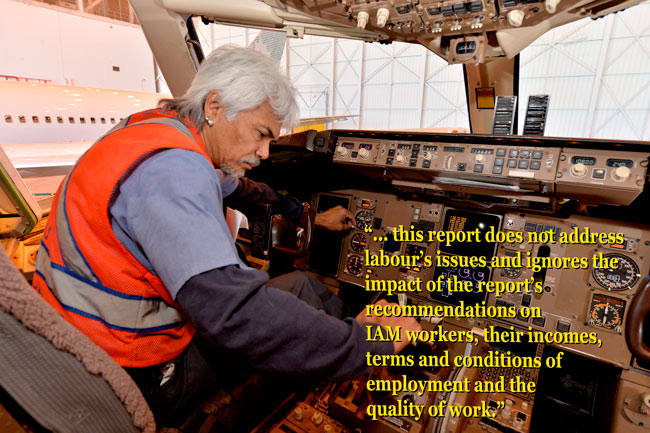
By Carlos DaCosta
IAM Airline Coordinator
On June 25, 2014, a review of the Canada Transportation Act was started by Federal Minister of Transport Lisa Raitt who then appointed David Emerson as chair of the committee. Mr. Emerson is a business executive and all of his advisors were from business and industry.
On February 25, 2015, Minister of Transport Marc Garneau tabled the Canada Transportation Act (CTA) report in Parliament. The report’s recommendations revolved around expansion of privatization, deregulation, and increased competition in the transportation industry.
The IAM has read this extensive 700+ page report which explains the three decades of deregulation, liberalization, and the sale of government assets. It examines rail, air and marine transport. It touches on the transportation needs of the North, climate change, technological innovation, and governance.
But this report does not address labour’s issues and ignores the impact of the report’s recommendations on IAM workers, their incomes, terms and conditions of employment and the quality of work.
The focus of the recommendations is on increased liberalization, regulatory harmonization, expanding access for private investment, and intensifying competitive forces, all which have huge negative impacts on the workforce in the air transport sector.
Some of the recommendations in the report include; opening Canadian Airport Authorities to private ownership, further deregulating Air transportation and increasing foreign ownership control of airlines.
Air Transport
In the mid-1980s, governments owned and operated infrastructure and service providers and regulated the transportation industry in Canada. In 1985 governments pursued commercialization, selling of assets, and deregulation of markets and liberalization of international trade.
.jpg) Between 1986 and 2006, Canada shifted to a commercial market driven system from one based on government ownership and direction. This transformation began with the deregulation of the domestic market for air services and the privatization of Air Canada, which resulted in job losses, service cuts, bankruptcies, consolidations and price hikes in regional markets.
Between 1986 and 2006, Canada shifted to a commercial market driven system from one based on government ownership and direction. This transformation began with the deregulation of the domestic market for air services and the privatization of Air Canada, which resulted in job losses, service cuts, bankruptcies, consolidations and price hikes in regional markets.
Following deregulation and privatization in the carrier sector, the government moved to commercialize larger airports and air navigation services.
This policy also established Nav Canada as a not for-profit, corporation that operates Canada’s air navigation system. The report’s solution to this problem is to create private, for-profit airports.
Regarding the above actions taken by past governments, the IAM has made it clear through its submissions, of its concerns on the possible impact that our members would face in the Air Transport Industry. To date, most of our fears have become reality.
The Emerson report recommends moving within three years to a share-capital structure for the larger airports, with equity-based financing from large institutional investors. The review describes 3 options for privatizing large airports.
Another recommendation of the report proposes increasing the scope for foreign ownership among airline carriers. Currently, bilateral service agreements generally require airlines to be substantially owned and effectively controlled within one of the countries party to an agreement. Most countries limit foreign ownership in airlines to between 0 and 49.9% of voting shares while Canada has a 25 percent limit as does the United States.
 The report recommends increasing foreign ownership to at least 49 percent for air carriers operating commercial passenger services and 100 percent for airlines operating all-freight and specialty air services.
The report recommends increasing foreign ownership to at least 49 percent for air carriers operating commercial passenger services and 100 percent for airlines operating all-freight and specialty air services.
Another area covered in the report is airport security and passenger screening. We are presently at risk of experiencing longer line ups unless the Government increases funding to address an increase in passenger levels which has over the last five years increased by 21% while the funding received has not kept pace. On average, passenger levels in Canada are increasing by 3.5% each year.
The recommendations do not sufficiently address this problem and the government continues to pocket revenues collected from every passenger air ticket. We would like to see the government needs to direct all of the revenue collected as was intended so that more airport pre-board screeners can be hired to reduce passenger lineups at airports.
This report does not address the concerns and issues being experienced by those working in the transportation sector. Also health and safety issues are completely omitted from the report.
Interestingly, many of the recommendations in the CTA review report are at odds with and contradict the Liberal government’s objective of “strengthening the middle class, and helping those working hard to join it.” It will be interesting to see how our newly elected Liberal government will react.

